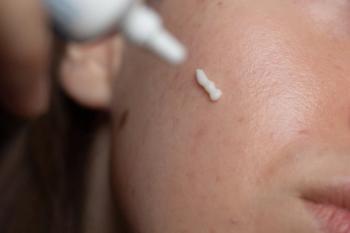
- Dermatology Times, July 2025 (Vol. 46. No. 07)
- Volume 46
- Issue 07
Integrating Ruxolitinib, Excimer Laser, and Emerging Therapies for Vitiligo
At a recent Dermatology Times Case-Based Roundtable event, Michael Gold, MD, explored innovative vitiligo treatment strategies through complex cases and emerging therapies.
In a dynamic and interactive Dermatology Times Case-Based Roundtable event, Innovative Approaches in Vitiligo Treatment: Case-Based Strategies for Management, Michael Gold, MD, guided clinician attendees through 3 challenging vitiligo cases, reinforcing both the complexity of treatment and the emotional and social factors that affect therapeutic decisions. Gold, a board-certified dermatologist, founder, and director of Gold Skin Care Center in Nashville, Tennessee, highlighted topical ruxolitinib (Opzelura; Incyte), excimer laser therapy, and emerging treatments, emphasizing that vitiligo remains a largely individualized condition.
Case No. 1: Adolescent with Facial and Scalp Involvement
The first case involved a 13-year-old girl with vitiligo affecting the forehead, scalp, and eyelashes. Topical ruxolitinib was initiated, with marked repigmentation of the forehead over time. However, the eyelashes and scalp showed only modest improvement. Gold emphasized setting realistic timelines and expectations with patients and families—clearance is not rapid, and results vary by anatomical site. The eyelashes, in particular, remained refractory, and excimer laser was discussed as a potential next step for the scalp, though not recommended for the periocular area. The broader conversation addressed how psychosocial impacts often vary more by perception than by lesion extent: was the patient or her parents more distressed? This distinction informed whether to escalate treatment or adopt a maintenance and observation approach.
"This is a difficult case, but what the attendees said is that this isn't something that is going to go away quickly. We may need some other treatment down the line when something new comes out, whether it's one of the orals or injectables that are in the pipeline," Gold said.
Case No. 2: Longstanding Vitiligo with Hand and Facial Involvement
The second case illustrated the treatment trajectory of a 35-year-old woman who had tried mild facial topical steroids, more potent agents on the hands, and calcineurin inhibitors (eg, tacrolimus, pimecrolimus), eventually progressing to ruxolitinib. Discussion extended beyond pharmacology to include the concept of camouflage products as a practical tool in this patient’s routine, particularly for facial lesions. Attendees raised the point of cosmetic adaptability and technique, particularly in young individuals who may normalize camouflage use. Another key moment was the mention of newly FDA-approved autologous skin cell suspension, opening new surgical options for treatment-resistant areas such as the hands.1 Gold highlighted this as a promising adjunct, particularly for patients with stable disease and localized depigmentation.
Case No. 3: Segmental Vitiligo in a Child Under 12
The final case reviewed an 8-year-old girl with classic segmental vitiligo. Off-label use of topical ruxolitinib, though not currently approved under age 12, was part of the treatment regimen, alongside excimer laser therapy. The patient achieved notable repigmentation, particularly with laser, reinforcing its role in localized disease when applied consistently. However, the issue of access was raised: excimer laser remains uncovered for most vitiligo patients, despite demonstrated benefit.
"The biggest issue that we deal with in a patient like this is that excimer laser is not covered in 99% of our vitiligo patients. So, it's a lot of money, it's a lot of treatments, and you have to factor that into what you're doing," Gold noted.
The case discussion closed with consensus on the importance of balancing medical appropriateness with practical and emotional factors, particularly in pediatric cases where disease visibility intersects with developmental identity.
Practice Implications
Gold concluded with a preview of the therapeutic horizon (Figure 1). Attendees expressed particular enthusiasm about the prospect of oral agents for vitiligo, noting that while IV biologics exist in the pipeline, systemic pills, if effective and safe, could become a game changer. The potential for new topicals, and perhaps injectables, also generated discussion around real-world adoption pathways.
Figure 1. Vitiligo Pipeline2
Drugs/Molecule
Mechanism of Action
Clinical Trial Phase
Povorcitinib
JAK1 inhibitor
Phase 3
Afamelanotide
α-MSH analog
Phase 3
Ritlecitinib
JAK3/TEC inhibitor
Phase 3
Upadacitinib
JAK1 inhibitor
Phase 3
Repibresib
Soft pan-BD BET inhibitor
Phase 2
MK-6194
IL-2 mutein Fc fusion protein
Phase 2
AMG 714
Anti-IL-15 monoclonal antibody
Phase 2
α-MSH, alpha-melanocyte stimulating hormone; BD, bromodomain; BET, bromodomain and extra-terminal;
Fc, fragment crystallizable; IL, interleukin; JAK, Janus kinase; TEC, tyrosine kinase expressed in hepatocellular carcinoma.
References
- Hamzavi IH, Ganesan AK, Mahmoud BH, et al. Effective and durable repigmentation for stable vitiligo: a randomized within-subject controlled trial assessing treatment with autologous skin cell suspension transplantation. J Am Acad Dermatol. 2024 Dec;91(6):1104-1112. doi: 10.1016/j.jaad.2024.08.027
- Seong SH, Oh SH. Up-and-coming drugs for the treatment of vitiligo. Ann Dermatol. 2024; 197-208.
https://doi.org/10.5021/ad.24.038
Articles in this issue
5 months ago
Dermatology Times July 2025 Print Recap5 months ago
Is AI Transforming Skin Care?5 months ago
The Value of RAD, According to Clinicians5 months ago
A New Canvas for Conversations in DermatologyNewsletter
Like what you’re reading? Subscribe to Dermatology Times for weekly updates on therapies, innovations, and real-world practice tips.


















